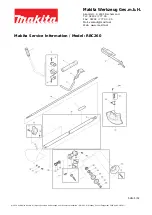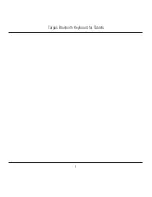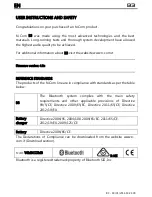
OPERATION
-
MOTOR
UNITS
The
manoeuvring
system
has
two
motor
units
(1
&
2).
In
general
they
are
mounted
in
front
of
the
axle
of
the
caravan.
Both
units
are
identical
but
cannot
be
switched.
Fig.
4
A.
Aluminium
drive
roller
B.
12V
Motor
C.
Motor
connection
terminals
(+
and
-)
D.
Motor
for
automatic
engaging
system
E.
Base
unit
F.
Drive
unit
G.
Gear
Traction
indicator
label:
The
yellow-green-red
traction
indicator
label
(Fig.
11A),
on
the
side
of
each
motor
unit
indicates
if
the
roller
is
depressing
the
tyre
sufficiently
to
provide
adequate
traction.
If
the
pointer
is
in
the
yellow
area
Rollers
are
not
touching
or
depressing
the
tyre
sufficiently.
If
the
pointer
is
in
the
green
area
Rollers
should
be
connecting
correctly
to
the
tyre
(margin
of
15mm).
If
the
pointer
is
in
the
red
area
Rollers
are
connected
to
the
tyre
but
in
an
extreme
position.
It
could
be
that
the
tyre
of
the
caravan
has
insufficient
air
pressure
or
the
drive
unit
has
been
knocked
out
of
position
and
a
visit
to
a
workshop
is
required
to
reposition
the
assembly.
Disconnect
the
motor
powered
rollers
in
case
of
emergency:
In
the
case
that
the
caravan
battery
is
discharged
to
far
to
automatically
take
of
the
motor
powered
rollers
of
the
tyre,
or
there
is
a
defect,
you
can
also
do
this
manually.
See
figures
9
&
9.1.
Take
the
plastic
cap
(Fig.
9B)
at
the
rear
side
of
the
housing
of
the
motor
for
the
automatic
engaging
system.
If
necessary
use
a
screwdriver.
Place
the
emergency
key
(6)
on
the
emergency
socket
in
the
motor
unit
(Fig.
9A
&
9.1C)
and
turn
it
until
the
motor
unit
including
motor
powered
rollers
are
in
the
beginning
position.
Repeat
this
also
on
the
motor
unit
on
the
other
side.
Put
the
plastic
caps
back
on
the
motor
housing.
As
soon
as
the
battery
is
charged
again,
or
the
problem
is
solved,
the
motor
powered
rollers
automatically
work
again.
OPERATION
-
REMOTE
CONTROL
HANDSET
The
remote
control
handset
(5)
is
powered
by
one
PP3
9Volt
battery,
and
is
activated
by
moving
the
slide
switch
to
-I
(Fig.
5A).
Once
activated
the
green
LED
(Fig.
5H)
will
illuminate
and
the
directional
controls
can
now
be
used.
Fig.
5
A.
Slide
switch
O
and
-I)
B.
Caravan
forwards
(both
wheels
rotate
in
forwards
direction)
C.
Caravan
reverse
(both
wheels
rotate
in
reverse
direction)
D.
Caravan
left
forwards
(right
wheel
rotates
in
forwards
direction)
E.
Caravan
right
forwards
(left
wheel
rotates
in
forwards
direction)
F.
Caravan
left
reverse
(right
wheel
rotates
in
reverse
direction)
G.
Caravan
right
reverse
(left
wheel
rotates
in
reverse
direction)
H.
Green
LED:
reflects
status
of
the
remote
control
and
caravan
manoeuvring
system
I.
Two
handed
service
for
automatic
engaging
of
the
motor
powered
rollers
to
the
tyre
J.
Two
handed
service
for
automatic
disengaging
of
the
motor
powered
rollers
from
the
tyre
K.
Blue
LED:
reflects
status
of
the
automatic
engaging
system
L.
Red
overload
LED:
Amp
overload
protection
is
activated.
Wait
about
60
seconds
and
try
again.
M.
Blue
9V
battery
LED:
The
internal
9V
battery
of
handset
is
near
empty
and
needs
to
be
replaced.
N.
Blue
battery
voltage
LED:
Caravan
battery
voltage
too
low
or
too
high.
When
you
drive
straight
forwards
or
reverse
(press
button
B
or
C),
it
is
also
possible
to
adjust
the
direction
by
additional
pressing
button
D
or
E
(when
driving
forwards)
or
button
F
or
G
(when
driving
reverse).
In
addition,
the
(E)
and
(F)
buttons
or
(D)
and
(G)
buttons
may
be
pressed
at
the
same
time
to
turn
the
caravan
around
on
its
own
axis
without
moving
forward
or
backward
(this
function
just
can
work
under
the
-axle
When
you
switch
within
2
seconds
from
forward
driving
to
reverse
driving
(and
the
other
way
around),
a
small
delay
of
1
second
will
appear
to
protect
the
electronics
and
the
motors.






































